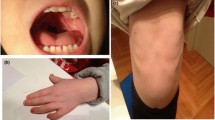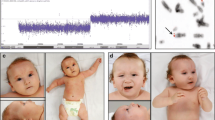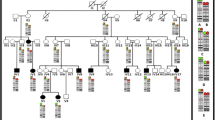Abstract
A de novo complex chromosomal rearrangement is very rare but likely to be present in a child with developmental disabilities and physical alterations. A child presented in this study showed global developmental delay and some typical phenotypes. Initial karyotyping and FISH analysis in the patient showed an apparently de novo balanced translocation between chromosome 3 and 8, t(3;8)(q13.1;q24.2). Further analysis using multiplex ligation-dependent probe amplification and array-based comparative genomic hybridization revealed a cryptic microdeletion on 3p13 region. Nearly one-third of balanced rearrangements are reported to involve cryptic disruptions at breakpoints, however, the microdeletion of the proposita was present in non-translocated region of the chromosome 3. After careful reevaluation of the results, a pericentric inversion, inv(3)(p13q13.1) that induced deletion was revealed. The clinical features of developmental delay in cognition, language, and motor function and facial and physical phenotype of the proposita were similar to those found in the children with 3p13 deletion. This case shows that combined molecular cytogenetic techniques with routine karyotyping are very useful to identify subtle genomic changes associated with abnormal phenotypes.





Similar content being viewed by others
Change history
27 December 2016
An erratum to this article has been published.
References
Bosio Y, Berto G, Camera P, Bianchi F, Ambrogio C, Claus P, Di Cunto F (2012) PPP4R2 regulates neuronal cell differentiation and survival, functionally cooperating with SMN. Eur J Cell Biol 91:662–674
De Gregori M, Ciccone R, Magini P, Pramparo T, Gimelli S, Messa J, Novara F, Vetro A, Rossi E, Maraschio P et al (2007) Cryptic deletions are a common finding in “balanced” reciprocal and complex chromosome rearrangements: a study of 59 patients. J Med Genet 44:750–762
Ferland RJ, Cherry TJ, Preware PO, Morrisey EE, Walsh CA (2003) Characterization of Foxp2 and Foxp1 mRNA and protein in the developing and mature brain. J Comp Neurol 460:266–279
Gribble SM, Prigmore E, Burford DC, Porter KM, Ng BL, Douglas EJ, Fiegler H, Carr P, Kalaitzopoulos D, Clegg S et al (2005) The complex nature of constitutional de novo apparently balanced translocations in patients presenting with abnormal phenotypes. J Med Genet 42:8–16
Hamdan FF, Daoud H, Rochefort D, Piton A, Gauthier J, Langlois M, Foomani G, Dobrzeniecka S, Krebs MO, Joober R et al (2010) De novo mutations in FOXP1 in cases with intellectual disability, autism, and language impairment. Am J Hum Genet 87:671–678
Kleinjan DJ, van Heyningen V (1998) Position effect in human genetic disease. Hum Mol Genet 7:1611–1618
Krohn A, Seidel A, Burkhardt L, Bachmann F, Mader M, Grupp K, Eichenauer T, Becker A, Adam M, Graefen M et al (2013) Recurrent deletion of 3p13 targets multiple tumour suppressor genes and defines a distinct subgroup of aggressive ERG fusion-positive prostate cancers. J Pathol 231:130–141
Ku GM, Pappalardo Z, Luo CC, German MS, McManus MT (2012) An siRNA screen in pancreatic beta cells reveals a role for Gpr27 in insulin production. PLoS Genet 8:e1002449. doi:10.1371/journal.pgen.1002449
Le Fevre AK, Taylor S, Malek NH, Horn D, Carr CW, Abdul-Rahman OA, O’Donnell S, Burgess T, Shaw M, Gecz J et al (2013) FOXP1 mutations cause intellectual disability and a recognizable phenotype. Am J Med Genet A 161A:3166–3175
Madan K, Nieuwint AW, van Bever Y (1997) Recombination in a balanced complex translocation of a mother leading to a balanced reciprocal translocation in the child. Review of 60 cases of balanced complex translocations. Hum Genet 99:806–815
Menten B, Maas N, Thienpont B, Buysse K, Vandesompele J, Melotte C, de Ravel T, Van Vooren S, Balikova I, Backx L et al (2006) Emerging patterns of cryptic chromosomal imbalance in patients with idiopathic mental retardation and multiple congenital anomalies: a new series of 140 patients and review of published reports. J Med Genet 43:625–633
Moeschler JB, Shevell M (2014) Comprehensive evaluation of the child with intellectual disability or global developmental delays. Pediatrics 134:e903–e918
Pariani MJ, Spencer A, Graham JM Jr, Rimoin DL (2009) A 785 kb deletion of 3p14.1p13, including the FOXP1 gene, associated with speech delay, contractures, hypertonia and blepharophimosis. Eur J Med Genet 52:123–127
Sethi MK, Buettner FF, Krylov VB, Takeuchi H, Nifantiev NE, Haltiwanger RS, Gerardy-Schahn R, Bakker H (2010) Identification of glycosyltransferase 8 family members as xylosyltransferases acting on O-glucosylated notch epidermal growth factor repeats. J Biol Chem 285:1582–1586
Talkowski ME, Rosenfeld JA, Blumenthal I, Pillalamarri V, Chiang C, Heilbut A, Ernst C, Hanscom C, Rossin E, Lindgren AM et al (2012) Sequencing chromosomal abnormalities reveals neurodevelopmental loci that confer risk across diagnostic boundaries. Cell 149:525–537
Taylor BS, Schultz N, Hieronymus H, Gopalan A, Xiao Y, Carver BS, Arora VK, Kaushik P, Cerami E, Reva B et al (2010) Integrative genomic profiling of human prostate cancer. Cancer Cell 18:11–22
Tegay DH, Chan KK, Leung L, Wang C, Burkett S, Stone G, Stanyon R, Toriello HV, Hatchwell E (2009) Toriello–Carey syndrome in a patient with a de novo balanced translocation [46, XY, t(2;14)(q33;q22)] interrupting SATB2. Clin Genet 75:259–264
Thevenon J, Monnier N, Callier P, Dieterich K, Francoise M, Montgomery T, Kjaergaard S, Neas K, Dixon J, Dahm TL et al (2014) Delineation of the 3p14.1p13 microdeletion associated with syndromic distal limb contractures. Am J Med Genet A 164A:3027–3034
Vissers LE, de Vries BB, Veltman JA (2010) Genomic microarrays in mental retardation: from copy number variation to gene, from research to diagnosis. J Med Genet 47:289–297
Warburton D (1991) De novo balanced chromosome rearrangements and extra marker chromosomes identified at prenatal diagnosis: clinical significance and distribution of breakpoints. Am J Hum Genet 49:995–1013
Watson CT, Marques-Bonet T, Sharp AJ, Mefford HC (2014) The genetics of microdeletion and microduplication syndromes: an update. Annu Rev Genom Hum Genet 15:215–244
Funding
The study was supported by grant of Korean Ministry of Science, ICT and Future Planning (NRF-2013R1A1A3013182).
Author information
Authors and Affiliations
Corresponding authors
Ethics declarations
Conflicts of interest
Kye Hee Cho, Sung Han Shim, MinYoung Kim declares that they have no conflict of interest.
Ethical approval
All procedures performed in studies involving human participants were in accordance with the ethical standards of the institutional research committee and/or national research committee and with the 1964 Helsinki declaration and its later amendments or comparable ethical standards. This study was approved by the Institutional Review Board of CHA Bundang Medical Center. Approval of patient’s parents was obtained for disclosing the Fig. 1 in the article.
Rights and permissions
About this article
Cite this article
Cho, K.H., Shim, S.H. & Kim, M. A de novo 3p13 deletion induced by a complex chromosomal rearrangement combined with a pericentric inversion of chromosome, inv(3)(p13q12), and a translocation between chromosome 3 and 8, t(3;8)(q13.1;q24.2), in a child with developmental delay. Genes Genom 39, 121–126 (2017). https://doi.org/10.1007/s13258-016-0470-y
Received:
Accepted:
Published:
Issue Date:
DOI: https://doi.org/10.1007/s13258-016-0470-y




